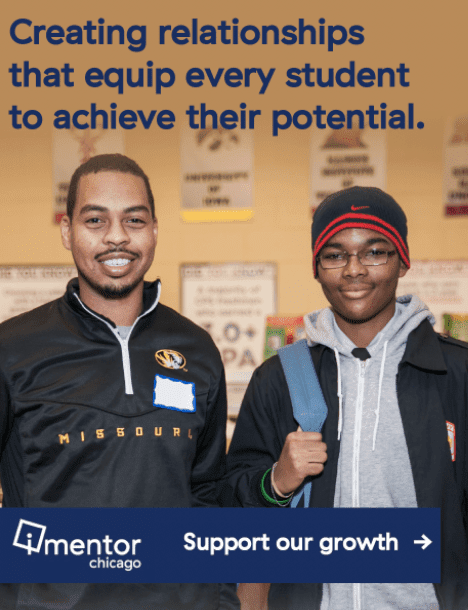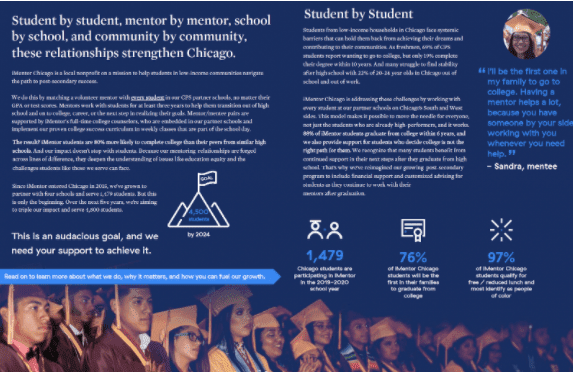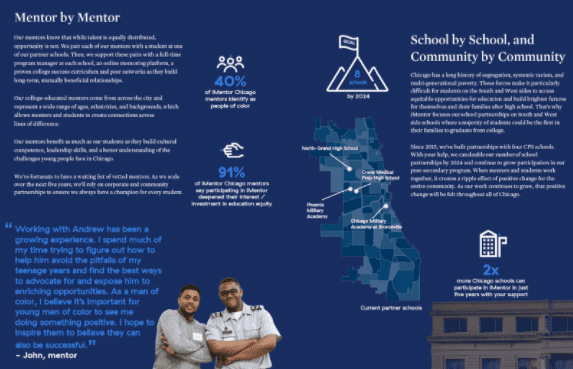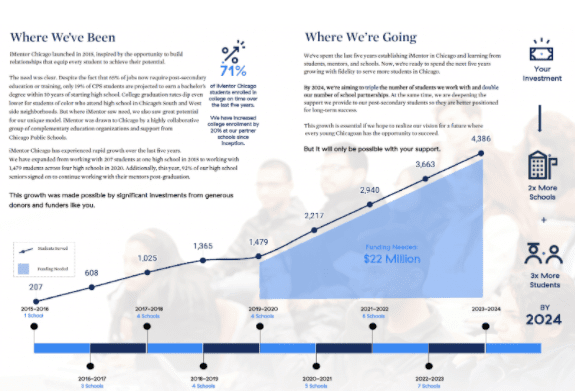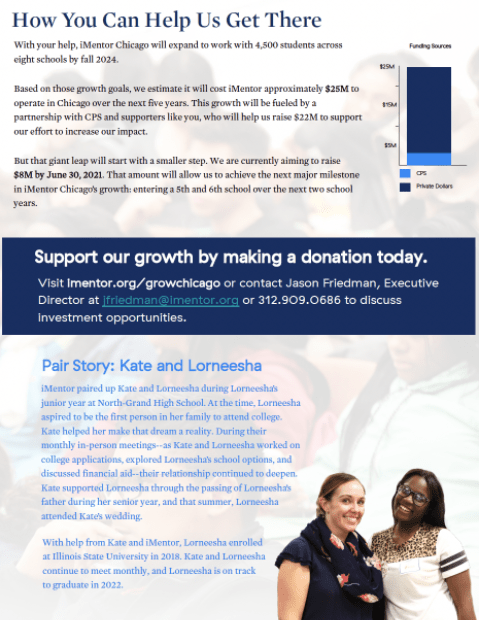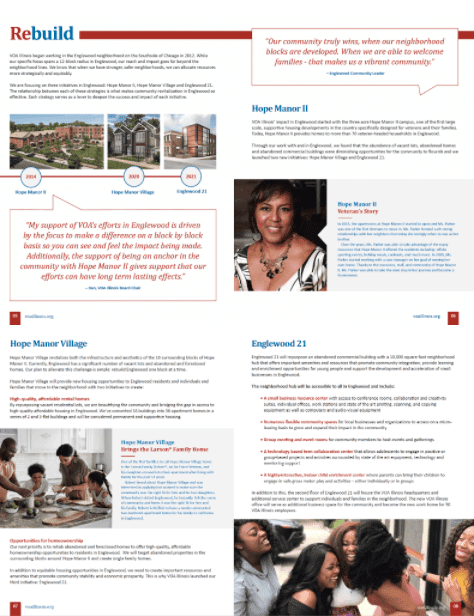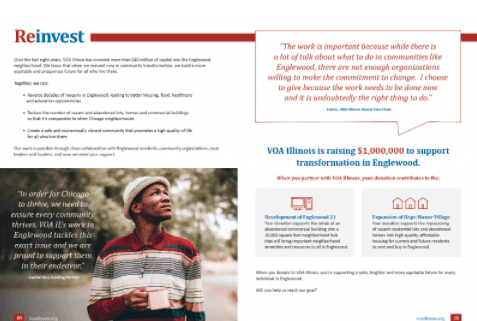Are you about to embark on the process of creating a case for support for your nonprofit? If so, you probably have dozens of questions about what to include, how to present important information, who to involve in the process and more. In this post, I’ll answer all those questions and more. Then, I’ll walk you step-by-step through a proven process for developing a compelling case for support, and I’ll dissect a few case for support examples and show you why they work. Ready? Let’s dive in.
Case for Support Basics: Questions and Answers
Q: What is a case for support?
A: A case for support (sometimes called a case statement or donor prospectus) is simply a piece of communication collateral that helps prospective donors understand why they should give money to your organization. A case for support can focus on a specific fundraising goal – like a capital campaign to fund a new facility, for example – or it can simply encourage donors to give unrestricted funds to your organization to support all of its activities and initiatives.
Q: What format should my case for support be in?
A: Most organizations develop their case for support as a written and well-designed document and then either print it and/or share it electronically as a PDF. Some also choose other creative formats, such as videos or interactive webpages.
Q: How do we use the case for support?
A: A case for support can be used in its entirety when communicating with prospective donors. You can send it to them ahead of a conversation, or put it in front of them while you’re talking and use it to guide your discussion. Many development teams also find it useful to pull tidbits of data or language from their case statements and then weave them into fundraising materials, grant applications, conversations with prospective donors, etc.
Q: What should we include in our case for support?
A: While every case for support is different, most include the following sections:
- Case summary: pull prospective donors in by explaining (very concisely) what your organization does and why it matters. Then, tease your fundraising goal, and explain why donor support is necessary to continue to grow your impact.
- Model/Programs/Services: explain how your organization makes a difference and illustrate your impact to date.
- History: help your prospective donors understand where your organization has been.
- Vision/future plans/goals: help your prospective donors understand where your organization is going. If your case for support is focused on a capital campaign or a specific goal (like building a new facility or launching a new initiative) this section will outline what you’re raising money for.
- Call to action: ask donors to give and show them how.
Most effective cases also make use of impact data and stories or quotes from the people who benefit from their programs and services.
Q: Who should be involved in developing our case for support?
A: Your development or fundraising team will likely lead the process of creating the case for support, but they shouldn’t be the only ones to touch it. We always advocate for developing a taskforce of both internal and external stakeholders when developing important, strategic collateral like a case for support. When it comes to internal stakeholders, consider including members of your senior leadership team, marcomm team members, and program staff from all key programs that will be represented in the case for support in addition to your development team. Aim to include a diverse cross-section of your organization’s staff, and involve people with a broad range of experience and tenure levels, race and gender identities, professional backgrounds etc. When it comes to external stakeholders, recognize that a significant portion of your case for support will focus on telling the stories of the people and communities your organization serves. You can’t do that effectively or equitably without including those people in the process, asking for their feedback on how they want to be represented and making sure that your final product feels true to their lived experience. And of course, we can’t forget donors and prospective donors. Since they’ll be the end-users of the case for support, involving them for input is hugely important. I’ll go into even more detail about who to include later in this post.
Q: Isn’t a case for support inherently needs-based?
A: You probably already know that my team and I are big advocates for strength-based messaging, and encourage taking a strength-based approach across all facets of a nonprofit’s communications and fundraising efforts. The case for support is no exception. Historically, many organizations have focused their case statements heavily on the needs and challenges that exist among the people and communities they work within an effort to “pull on donor heartstrings,” but this really isn’t necessary, and it can do more harm than good in the long run. Instead of focusing on the deficits that exist among the people you work with and positioning the donor as the “savior” who can fix their problems, try focusing on the opportunities that exist in their lives and the role donors can play in helping them realize those opportunities for themselves. If you’re struggling to pivot to a strength-based approach in this or any other fundraising or communications collateral, this post can help, and so can we.
How to Develop a Case for Support: A Step-by-Step Process
As we’ve guided a wide range of nonprofit organizations through the development of their case statements, we’ve developed a process that just works, and I’m excited to share it with you here.
Step one: Decide what you’re raising money for.
Will your case for support be focused on a capital campaign or other specific fundraising goal? Or are you simply looking to encourage donors to support all facets of your organization over the long term? Either way, your case for support will need to name a concrete goal you’re working toward, and you must decide what it is before you do anything else.
Step two: Decide who you are targeting.
Is your case for support focused on major gifts donors only? What about planned giving donors, corporate partners, mid-level donors, funders or others? While some case statements effectively speak to all these groups at once, doing so can be difficult. If you want to reach a broad range of different types of donors, you might consider developing a few different versions of your case for support, and modifying sections like the call to action in each one so that it aligns with the needs and giving capacity of a specific type of donor. No matter how you choose to approach this, it is important to figure out who will engage with your case for support before you get to work at developing it.
Step three: Involve the right people in developing the case for support.
As I mentioned previously, it’s critical to include a diverse range of both internal and external stakeholders in the development of your case for support. We suggest creating a small team of staff who will be intimately involved at every step of the process, as well as a larger group of both internal and external stakeholders who you’ll ask for input and feedback at key checkpoints along the way. Here’s who to consider including in that second, larger group:
- Internal stakeholders
- Key senior leadership staff
- Key board members
- A few members of your program staff, specifically from programs that will be heavily featured in the case for support
- Marcomm staff
- Development staff
- Volunteers
- External stakeholders
- People who utilize your organization’s programs and services
- Existing donors
- Target donors
- Existing corporate partners
- Target corporate partners
- Existing funders
- Target funders
- People in the communities where your programs and services are utilized
Depending on who you decide to include, you might get feedback from this larger group by pulling them all together into a focus group-like setting at several key points in the development of your case for support, or you might speak to them one-on-one or in small groups throughout the process.
Step Four: Establish key messages and create an outline or wireframe
Working with your small group of external stakeholders, decide on the most important key messages your case for support needs to communicate. Those key messages should ideally line up with other messaging that has been more broadly established for your fundraising department or organization as a whole. Then, get to work creating an outline or wireframe for your case for support. Since case statements are often visual documents, a sketched wireframe can often be a more useful way to visualize where you’re going than a written outline. Once you have an outline or wireframe together that your small group of internal team members feel good about it, run it by your larger group of internal and external stakeholders for feedback. This will be your first key checkpoint with that larger group, and it presents a great opportunity to have them shape your case before you get too far in developing it.
Step Five: Gather data, quotes and stories
Some donors respond better to individual stories, while others respond better to facts and figures. Aim to include enough of each to cater to both types of audiences, and then pepper them in across every section of your case for support. This is where taking a strength-based approach will come into play, and you should absolutely run any stories you plan to tell by the people featured in them (even if those people will be kept anonymous) to ensure the stories feel true to their lived experiences.
Step Six: Create the case for support
It’s finally time to create your case for support. After all the work you’ve already done, this part will come easily. The most challenging aspect is typically keeping your case for support concise enough to hold a busy donor’s attention. No matter what format you use, your case for support shouldn’t take a donor more than five minutes to fully digest. Because you’ll have set the process up to elicit feedback from many internal and external stakeholders, keep in mind that at this phase you’ll just be creating the first draft. Don’t get hung up on perfecting every little detail. Instead, make sure you’re hitting on the most important points, establishing a solid flow from one piece of information to the next (all the way through to the call to action), and taking a strength-based approach to asking for support.
Step Seven: Revise and refine
Once you have an initial draft together, seek feedback from the small group of internal stakeholders who have been most intimately involved in the process. Then, refine it based on their input and get a second draft in front of your larger group of internal and external stakeholders. Again, you can do this through one large focus group, several smaller ones, or individual conversations with a wide range of internal and external stakeholders.
Step Eight: Start using your case for support, and continue to iterate on it as needed
Once you’ve compiled feedback from all your stakeholders and arrived at a version of your case for support that everyone feels good about, it’s time to start using it in the real world. All your hard work will start to pay off as donors begin to better understand what your organization does and why they should support your goals. While you’re likely to end up with a very solid case for support if you follow this process, no case is ever final. Consider your case for support a living, breathing document and continue to iterate on it as you get more feedback from donors and reach key milestones on the road to achieving your goals.
Case for Support Examples
Now that you have a good understanding of how a case for support works and how to go about developing an effective one, you’re probably ready to take a look at some examples. You’re in luck, because I’m going to share two cases from Prosper’s clients that you can use to inspire your own.
iMentor Chicago’s Case for Support
Why it works: this case for support uses a creative narrative structure to help donors understand the organization’s impact and the role they can play in helping to grow it. It starts small, by illustrating how the organization impacts individual students and mentors, and then expands out to its impact on schools and entire communities. It then closes with a compelling, graphical representation of the organization’s actual growth over the last several years and their projected growth that will be made possible with donor support. Strength-based stories are peppered throughout the entire case for support, as is data (in infographic format). Finally, the goal is made abundantly clear, and donors know exactly what they need to do if they want to support the organization.
VOA Illinois’ Case For Support
Why it works: This case for support focuses on a very clear fundraising goal ($1M) for a very specific purpose (transforming Chicago’s Englewood neighborhood). It uses a theme of reimagine, rebuild, reinvest to bring donors along with the work they’re doing in the neighborhood, and the work they could do with more support. Quotes are used heavily to allow the people VOA serves to tell their own stories, and several different program types are highlighted in order to appeal to a range of donors.
Do you need more help with your case for support?
Drop us a note – we’d love to chat. You can also read more about our broader body of work with iMentor Chicago here and VOA Illinois here.
